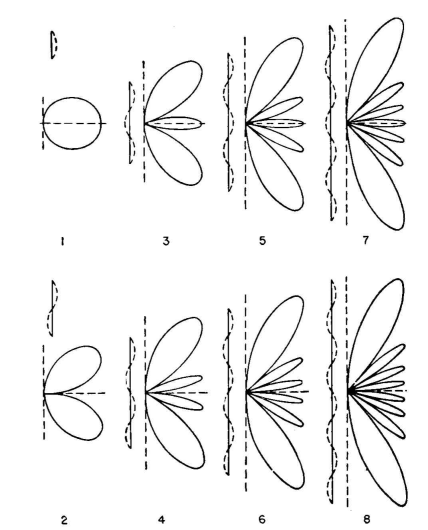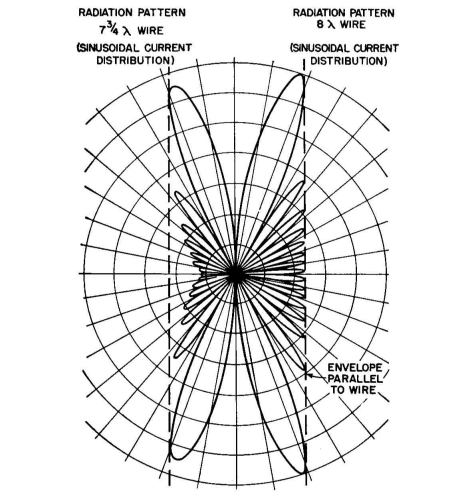| Radio Antenna Engineering is a free introductory textbook on radio antennas and their applications. See the editorial for more information.... |

|

Home  High-frequency Antennas High-frequency Antennas  Long-wire Antennas Long-wire Antennas  Long Wires with Standing Waves Long Wires with Standing Waves |
||||||






|
||||||
|
Long Wires with Standing WavesAuthor: Edmund A. Laport If it were possible to excite a long, straight wire so as to have several successive nodes and antinodes of current along its length in the form of a pure standing wave, such a wire, in free space, would have a radiation pattern of the form shown in Fig. 3.65. Such patterns, in general, have the following properties:
If the amplitude of current at each antinode is identical throughout the wire, and if the wire is an integral number of half wavelengths, then the envelope for the field-strength pattern for the system is a line (or cylinder) parallel to the wire itself and tangent to the main lobe. This is illustrated by the right-hand pattern of Fig. 3.66, which represents the pattern of an eight-wavelength wire with sinusoidal standing-wave current distribution. If the wire is of arbitrary length, then the various minor lobes are irregular and do not extend as far as the tangent to the main lobe. The left-hand portion of Fig. 3.66 shows the radiation pattern for a 7 3/4-wave-length antenna to illustrate this effect. When the wire is end-fed, as is often the case in practice, the radiation losses for a long wire cause a substantial traveling wave to exist, which causes the amplitude of successive current maximums to taper off toward the free end. This causes the pattern for a system to become intermediate between that of a pure standing-wave system and a pure traveling-wave system. This effect is shown in Fig. 3.23.
The shape of the field-strength pattern for a pure standing-wave system an integral number of half wavelengths long is specified by the relation:
in which m is the number of half wavelengths in the length of the straight wire bearing a pure standing wave. When m is an even number, the sine is used; the cosine is used when m is odd.
|
||||||
Home  High-frequency Antennas High-frequency Antennas  Long-wire Antennas Long-wire Antennas  Long Wires with Standing Waves Long Wires with Standing Waves |
||||||
Last Update: 2011-03-19




